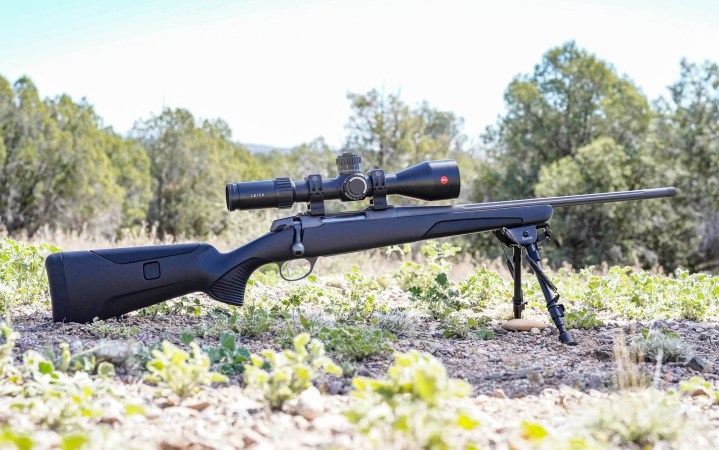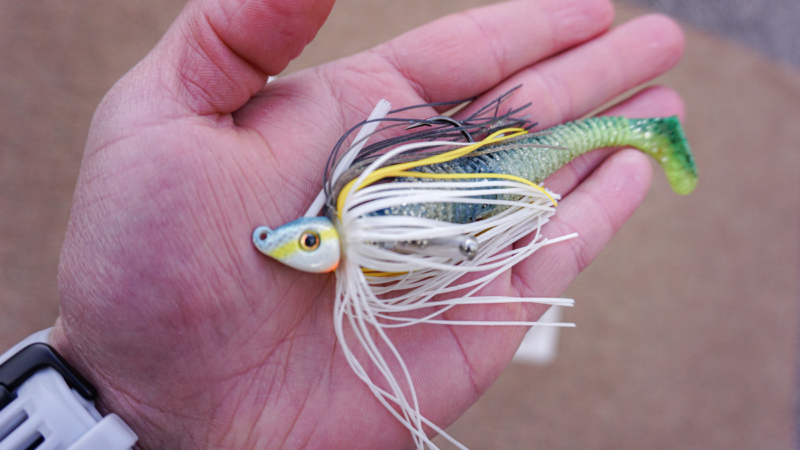Sako 90 Adventure Review
We may earn revenue from the products available on this page and participate in affiliate programs. Learn More ›
If one set out to design the perfect traditional hunting rifle it would look a lot like the Sako 90 Adventure. At first glance you might wonder whether such praise is warranted. The traditional American stock isn’t nearly as avant-garde as many of the competition-inspired lightweight stocks that have gained traction in recent years. And the heart of the rifle — Sako’s three-lug bolt action — has been a fixture in the Finnish gunmaker’s line for decades.
A close examination will quickly show that this is no ordinary rifle, however. The Sako 90 Adventure is, in a word, thoughtful. Every place the shooter interacts with the rifle — the cheekpiece on the stock, where the hands grasp the grip and forend, the tab that releases the magazine, the safety and trigger — shows evidence of refined design and a deep understanding of what hunters need in their rifles.
Sako has been at this a long time, of course. The elegance contained within the new 90 series didn’t just fall out of the sky. No company has better instincts when it comes to making big-game rifles. And no company does a better job delivering on those essential qualities while avoiding unnecessary frills.
Sako 90 Adventure Specs
- Action: Three-lug bolt
- Cartridge: 6.5 Creedmoor (tested)
- Capacity: 5+1
- Barrel: 20.1 inches, cold-hammer forged, 1:8 twist
- Muzzle: Threaded M15x1 (comes with 5/8-24 adapter)
- Length: 40 ¼ inches
- Weight: 6 pounds, 9 ounces (measured)
- Trigger: User adjustable from 2 pounds, 1 ounce to 4 pounds, 2 ounces (measured)
- Stock: Fiberglass and carbon fiber with adjustable cheekpiece
- Price: $2,699
Key Features
- Integral split Picatinny rail to mount optics
- Simple trigger weight adjustment mechanism
- Easy loading double-stack magazine that sits flush with stock
- Available in 22-250 Rem, 243 Winchester, 6.5 Creedmoor, 7mm-08, 308 Win, 6.5×55 SE, 270 Winchester, 30-06 Spring., 8x57IS, 270 WSM, 300 WSM, 6.5 PRC, 7mm Rem Mag, 300 Win Mag
Review Highlights
- Smooth, flawless operation
- More user-friendly design
- Excellent ergonomics and handling
- Accuracy: Average 5-shot group size .940 inches, measuring 38 groups with nine different types of ammo.
Best Performing Ammo
The Sako 90 Adventure shot many types of ammunition very well. To my surprise, the ammunition that did best was the non-lead Sako 120-grain Powerhead Blade, which averaged .585 inches. I shot four consecutive groups with this ammo that printed a 20-shot aggregate group that measured 1.13 inches with an impressive mean radius of .25 inches. It is unusual to find monometal (aka copper alloy) hunting ammunition that outperforms match ammo, but that was the case here. The 20-shot group was calculated by overlaying the four five-shot groups and plotting all the impacts relative to the same point of aim.
Here’s how the top shooting ammunition stacked up.
| Ammunition | Avg. Group Size | No. of 5-shot Groups |
| Sako 120-gr. Powerhead Blade | 0.585 in. | 4 |
| Federal 140-gr. Centerstrike | 0.793 in. | 4 |
| Sierra 140-gr. Tipped Gameking | 0.815 in. | 4 |
| Berger 144-gr. Long Range Hybrid Target | 0.837 in. | 6 |
| Federal 140-gr. Fusion | 0.854 in. | 8 |
Sako 90 versus Sako 85
The new 90 series looks very much like the Sakos that preceded it. There’s no mistaking the rifle’s provenance. The three-lug action, stock geometry, safety system, and magazine design are identical, or nearly so.
Upgrades and changes to the Sako 90 include:
- Adjustable trigger with faster lock time
- Modified bolt face, feeding and ejection system
- Integrated split Picatinny rail (on some models)
- Modified ejection port
- Modified bolt takedown
- Carbon fiber barrel (on Sako 90 Quest Ultra)
Sako 90 Action
On the exterior the most notable difference between the 85 and 90 actions is the shape of the ejection port and the addition of an integral split Picatinny rail on the receiver. The rail is a welcome development as it frees the user from needing to purchase Sako-specific rings or bases, thereby simplifying scope mounting.
Compared to the Sako 85, which had a wide-open loading port, the Sako 90 action is more enclosed with a strip of metal forming a bridge between the rail sections. Additionally, the ejection port is scalloped along its perimeter, where it was squared-off on the 85.
I couldn’t tell you whether these changes alter the rigidity of the action, its weight, or change the performance in any meaningful way, but it does give the 90 an updated look. More importantly, the Sako 90 still gives the user plenty of room to top load rounds.
Scott Einsmann
From Controlled-Round to Push Feed
The Sako 85 had a controlled-round feed action with a mechanical ejector that has been replaced by a push-feed action with dual plunger ejectors on the Sako 90. The extractor, which is positioned between two of the bolt lugs, remains the same.
Comparing the bolt faces side-by-side, the Sako 90 supports the cartridge around its entire perimeter, where on the 85 the bottom third of the bolt face was open and included a machined groove for the spring-loaded ejector to ride in. I’ll be curious to hear from Sako’s engineers whether the new design is able to handle higher chamber pressures than the old one.
I’ve never had any feeding, extraction, or ejection issues with my Sako 85s, but on occasion you’d hear rumbling from someone who did, and perhaps these shifts were enacted to address those concerns. In any event, neither I nor any of the other members of the Outdoor Life gun test team experienced any failure or hesitancy in the new Sako 90 action when it came to its operation.
Smoother Cocking
Sakos are known for their smooth and easy cocking, especially for a three-lug action. While everyone loves the shorter (usually 60-degree) bolt throw on a three-lug action compared to the 90-degree rotation on a two-lug system, it comes at a cost. Specifically, the shooter needs to cam the firing pin back the same amount (all things being equal) over a shorter distance, and thus the cocking motion requires greater effort. This is why some three-lug actions are such a beast to run from the shoulder. (Cooper Rifles, especially those in long-action cartridges, were notorious in this regard — it will be interesting to see whether their new ownership is able to remedy that issue.)
The action on the Sako 90 Adventure I tested required a touch less effort to cock than the two Sako 85 Grey Wolf rifles I own, which were already quite smooth.
John B. Snow
Bedding System
Sako’s bedding system on the 90 series is essentially unchanged from the 85. The flat-bottomed action has a small rectangular lug that protrudes from it and is where the front action screw threads into the action. That shallow lug nestles into a rectangular cut on the actual recoil lug, which is sandwiched between the action and stock. The front of the recoil lug is .337 inches thick and extends .5 inches deep into the recoil lug recess in the stock. This proven and efficient system is strong and creates a solid connection between the action and stock while minimizing the chance of introducing accuracy-degrading torque on the receiver.
The action screws also have plenty of thread engagement in the receiver, which reduces the possibility of having a screw come loose and experiencing a zero-shift or loss of accuracy.
Bolt Takedown
Where the bolt on the Sako 85 could be serviced in the field by hand, the Sako 90 requires use of an included tool. The issue with the 85 is that after removing the bolt from the rifle a simple twist on the bolt shroud would undo it, potentially causing bits and pieces to fly everywhere if you weren’t prepared. So, in the spirit of the Scandinavian social safety net, Sako designed the bolt on the 90 to stay in one piece unless you have the necessary tool (and intention) to take it apart.
John B. Snow
Sako 90 Trigger
One undeniable improvement on the Sako 90 is the trigger, which can be adjusted by inserting a T-20 Torx driver through a hole in the trigger guard. (The rifle comes with a T-handled driver for this purpose.) The trigger has five settings to choose from that are marked by lines of varying widths. The wider the line, the heavier the trigger pull. On my sample the trigger pulls at each setting measured as follows:
- 2 pounds, 1 ounce
- 2 pounds, 8 ounces
- 3 pounds, 0 ounces
- 3 pounds, 9 ounces
- 4 pounds, 2 ounces
A couple things stand out here. One is the nearly perfect half-pound increments between each setting. It impresses me that Sako was able to engineer that. Second is the useful (and appropriate) range of adjustment that goes from 2 to 4 pounds, which is perfect for a hunting rifle.
The trigger boasts a blazing fast lock time, which is the amount of time required for the firing pin to fall and strike the cartridge primer. I wasn’t able to measure this myself, of course, but if we take Sako’s word for it the lock time is less than 1.3 milliseconds, which makes it one of the fastest triggers out there. According to published reports, the lock time on a typical Remington 700 short action is around 2.6 ms, while a Winchester M70 is 3 ms, and a Savage AccuTrigger is 1.6 ms.
A fast lock time lessens the chance that the rifle’s point of aim will shift between the moment the sear breaks on the trigger and the striking of the primer by the firing pin. This is desirable on any rifle but is especially important in competition.
The trigger break is crisp and clean at every setting with no perceptible creep prior to the sear disengagement. The trigger also adjusts for reach. A small set screw when loosened lets you slide it back and forth to fine tune its position. By every metric, Sako did a great job with this fire control system.
Sako 90 Adventure Stock
The stock on the Adventure is simple, functional, strong, and well finished. It is constructed of fiberglass that’s reinforced with carbon fiber around the receiver and recoil lug and weighs a touch over two pounds (33.5 ounces on my scale).
The stock contributes heavily to the Sako’s excellent accuracy, both from the bench and while shooting from practical field positions.
First, it is extraordinarily stiff with barely any give even when subjected to strong lateral pressure. Also, the inletting is expertly executed with clean edges and precise cuts so that it perfectly mates with the receiver. Both attributes benefit accuracy by supporting the action in a consistent and rigid manner.
Ergonomics and Accuracy
The stock’s design also plays a role with how well the rifle shoots. The American Classic geometry, with its signature flat comb, is augmented by a cheekpiece with a push-button height adjustment mechanism. This user-friendly design gets the shooter’s eye lined up behind the scope in a consistent manner. (It’s also handy to be able to drop the cheekpiece quickly to its lowest setting when it comes time to pull the bolt and clean the barrel or when bore sighting the rifle.)
The grip has a deep radius that positions the trigger hand more vertically than an old-school American Classic stock. This lets the shooter pull the stock into the shoulder more easily and provides excellent trigger control.
Sako inset a rubbery material into the grip and forend that provides great traction for the shooter’s hands. I don’t know what it is made of exactly, but it has the best feel of any material I’ve seen added to a stock for that purpose.
The rubbery stuff has a faceted texture that’s attractive and gives the rifle a cool and modern vibe. The rest of the stock is beautifully finished as well. The color on the stock is even and smooth with no visible seams or machining marks and stood up to some harsh knocks and dings during the evaluation. That clean and lustrous finish extends to the inletted portion of the stock too. As with everything else on the Sako 90, you can tell it was made with a great deal of professional pride.
John B. Snow
Sako 90 Adventure Barrel
The metalwork is finished to the same aesthetically pleasing standards. The stainless-steel action and barrel have a tungsten colored Cerakote applied to them that offers good environmental protection and compliments the look of the stock.
One way to gauge the quality of a firearm’s coatings is to examine how well (or not) different components match. In the case of my Sako 90, the finishes on the barrel, action, muzzle adapter, bolt handle, bottom metal and magazine base are indistinguishable.
Cold Hammer Forged Barrel
I’m convinced Sako, through some sorcery, has tapped the magic of Ilmarinen, the ancient Finnish god who forged the dome of the sky and was an artificer and blacksmith known as “the eternal hammerer.” When it comes to decoding why their cold hammer forged barrels shoot as well as they do, it is as reasonable an explanation as any.
I’ve discussed Sako’s remarkable barrels before, including in my review of the TRG 22 A1, the most consistently accurate factory rifle I’ve tested. (To date, I have put 46 five-shot groups through the TRG 22 A1 for record. The largest group has measured .802 inches, and the average of all groups is .501 inches. That data set includes 13 different types of factory ammo.)
The Sako 90 Adventure’s barrel is cut from the same cloth. It had no trouble stacking bullets of different styles and weights and from different manufacturers into tiny, satisfying clusters.
According to Miikka Tamminen, Sako’s director of Research and Development, the cold hammer forging process also changes the metallurgic properties of the barrel steel, increasing its durability and resulting in a longer service life.
Metric Threads and Muzzle Adapter
The muzzle is threaded with a metric pitch, which is understandable given the needs of Finnish hunters and other European sportsmen for whom that is the norm. But is an understandable frustration to those of us hailing from the land of inches, yards, and miles.
To address this, Sako is shipping all 90 Series rifles with an adapter that steps the threads up to 5/8-24. I quickly swapped the barrel’s thread protector for the adapter so we could run suppressors on the rifle. Most of the accuracy work we did was with a can on board.
Sako Enters the Carbon-Fiber Barrel Era
The Sako 90 family has launched with seven different models and includes rifles with stocks made of wood, laminate, fiberglass, and carbon fiber. Open sights are an available option on some, as are set triggers. Sako’s done all this before. The one thing that’s new to the company is their first carbon-fiber barrel on the Sako 90 Quest Ultra, which has been announced but isn’t yet available.
Long-time Sako fans like me are eager to see how this new barrel format (which is still based on a cold hammer forged steel blank) stacks up against their traditional offerings.
Alex Robinson
Running the Sako 90 Adventure
It’s accurate. As sexy as a Havana nightclub. And durable as a pry bar. It would be a shame if its in-hand performance didn’t match these qualities — thankfully that’s not the case.
Everyone who shot the Adventure on our test team came away from the experience similarly impressed by how intuitive and natural it was to operate and run. And they were more than a little jealous that I got to take it home with me at the end of the test.
A Superlative Magazine
The double-stack metal magazine is among the finest ever devised. It loads effortlessly. Accommodates five rounds of 6.5 Creed. And sits flush in the stock. You can also top load it easily when it is empty. The release tab is recessed and has a locking mechanism that prevents it from getting knocked loose accidently. You can’t ask for more.
Two-Position Locking Safety
The safety is located behind the bolt handle in a spot that’s easy for the shooter’s thumb to locate. It has a low profile and toggles back and forth with minimal effort yet settles into the safe and fire positions in a positive manner. When on safe, the bolt locks in place, which is a great feature to have on a hunting rifle. A small tab between the safety and bolt handle will release the bolt when depressed so you don’t have to take the rifle off safe to open the action.
Positional Shooting
The rifle shot well with a bipod attached from the prone position, which is how we gathered the accuracy data. It tracked like a charm and the crosshairs settled back on target naturally as long as the shooter’s marksmanship fundamentals were squared away.
The recoil wasn’t harsh, but the rifle was even more of a pleasure to shoot offhand, kneeling and while resting it on a support bag. As I mentioned before, it cycled easily and performed in a flawless manner.
Sako 90 Adventure Pros and Cons
Normally, I’d start this by ticking off a bullet-pointed list of the things the rifle does well. But if you’ve made it this far, you already have a feel for its strong points, of which there are many.
I kicked off this review by saying that if you set out to design the perfect hunting rifle, it would look a lot like the Adventure. And that’s true. But it doesn’t mean the rifle doesn’t have a couple areas for improvement.
Damn Swivel Studs
Most bolt action rifles still come with swivel studs. I get it. People are used to them, and they are traditional. But today’s best designed stocks have relegated them to the garbage bin of history where they belong.
Instead, modern stocks have M-Lok slots, or — better yet — an inset section of Pic rail on the forend to take advantage of today’s best bipods. These systems also employ QD cups for attaching slings, which are stronger, less obtrusive, more versatile, and more convenient than swivel studs.
Any high-end hunting rifle — and the Sako 90 Adventure qualifies as such — should incorporate these features.
Final Thoughts
The Sako 90 Adventure — and the other members of the 90 series family — have taken a proven and beloved platform (the Sako 85) and breathed fresh life into the company’s hunting rifles.
I’ve read some comments complaining that the 90 isn’t a radical enough departure from the 85, and that the changes are timid and unsatisfying. I couldn’t disagree more. While I’d love to see the stock updated with some more modern features, I think the company made meaningful improvements to an already excellent system.
While at $2,699 it isn’t cheap, I think the rifle more than justifies that price with its quality and performance.
Anyone who takes the fit, feel, and function of their hunting rifle as seriously as its accuracy is bound to appreciate, and be drawn to, the Sako 90 Adventure. And when it is handed down to the next generation, they will doubtlessly appreciate it too.
The post Sako 90 Adventure Review appeared first on Outdoor Life.
Source: https://www.outdoorlife.com/guns/sako-90-adventure-review/






